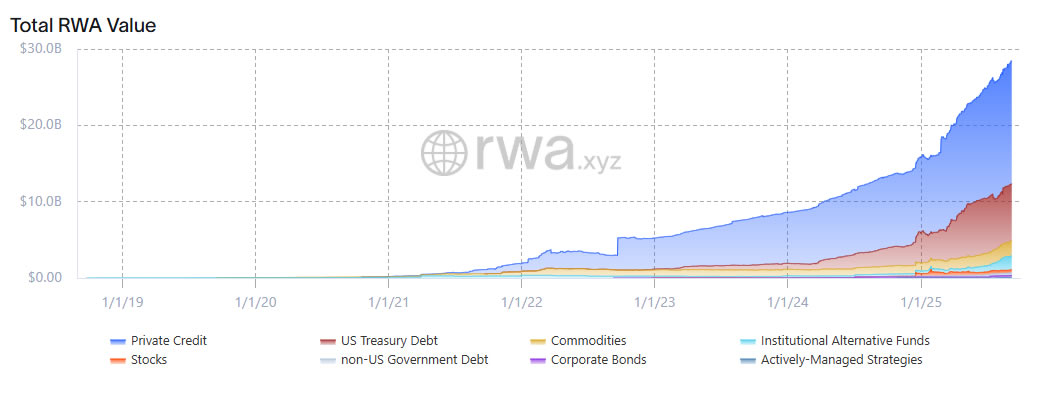Ant Digital May Tokenize $8.4B of Chinese Energy Assets on AntChain and Could List Tokens Offshore as Ethereum Leads RWA Market
ETH
ETH/USDT
$9,715,025,884.99
$3,171.49 / $3,090.00
Change: $81.49 (2.64%)
+0.0064%
Longs pay
Contents
Ant Digital tokenization is converting ¥60 billion (about $8.4 billion) of Chinese energy infrastructure into digital tokens on AntChain to unlock liquidity, enable fractional investment, and streamline financing—while exploring offshore listing options pending regulatory approval.
-
Tokenizing ¥60B of energy assets on AntChain to increase liquidity and broaden investor access.
-
Ant Digital has already raised ~¥300 million for three clean-energy projects using asset tokenization.
-
Onchain RWA value hit a record $28.4B; Ethereum holds ~57% market share (RWA.xyz data).
Ant Digital tokenization: Ant Digital is tokenizing ¥60B ($8.4B) of Chinese energy assets on AntChain — read financing, stablecoin plans, regulatory context, and next steps.
What is Ant Digital tokenization of energy assets?
Ant Digital tokenization is the process of converting physical energy infrastructure—solar panels, wind turbines, charging units—into tradable digital tokens recorded on AntChain. The program links device telemetry and performance data to onchain tokens to enable fractional ownership and more efficient financing.
How is AntChain being used to tokenize assets?
Ant Digital Technologies, an enterprise unit of Ant Group, is uploading operational data from ~15 million energy devices to AntChain. The firm is tokenizing roughly ¥60 billion (about $8.4 billion) of power infrastructure and has completed financing rounds for three projects totaling ~¥300 million (~$42 million).
Tokenization reduces reliance on traditional intermediaries, enabling direct digital issuance to investors, faster funding, and potential retail participation in infrastructure finance. The company is evaluating offshore decentralized exchange listings for secondary liquidity, subject to regulatory clearance.
Jack Ma’s Ant Digital is tokenizing billions of dollars’ worth of Chinese energy assets on AntChain, with plans to list the tokens on offshore exchanges.
Ant Digital Technologies, the enterprise solutions arm of the Jack Ma–backed Ant Group, is tokenizing 60 billion yuan (~$8.4 billion) of power infrastructure on its AntChain network, according to reporting by Bloomberg (plain text attribution).
The unit has been monitoring power output and outages from 15 million energy devices, including wind turbines and solar panels across China, and uploading this telemetry to its blockchain systems.
Ant Digital has completed financing for three clean-energy projects via asset tokenization, raising about 300 million yuan (~$42 million) in total, and plans to issue tokens linked to those assets.
Why are tokens being considered for offshore exchanges?
One future option for Ant Digital is to list asset-backed tokens on decentralized offshore exchanges to enhance liquidity for token holders. Executing this strategy depends on regulatory approvals and cross-border compliance assessments, as stated in reporting attributed to Bloomberg (plain text).
What financing milestones has Ant Digital achieved?
In August 2024 Ant Digital raised ¥100 million (~$14 million) for Longshine Technology Group by linking 9,000 electric charging units to AntChain. In December it secured over ¥200 million (~$28 million) for GCL Energy Technology through photovoltaic asset tokenization.
How big is the RWA tokenization market now?
Real-world asset (RWA) tokenization is nascent but expanding. Onchain RWA value recently reached a record $28.4 billion, per RWA.xyz (plain text attribution). More than half of that total is tokenized private credit; just over a quarter is tokenized U.S. Treasurys. Ethereum retains a roughly 57% market share for RWA tokenization.

RWA onchain value has surged this year. Source: RWA.xyz
What are Ant Group’s stablecoin ambitions?
Ant Group is pursuing stablecoin and cross-border payment infrastructure. Reports indicate collaboration efforts with stablecoin issuer USDC (Circle) integration and applications for stablecoin-related licenses for corporate payments via Ant International (plain text references).
Frequently Asked Questions
How does asset tokenization work for energy infrastructure?
Asset tokenization mints digital tokens representing ownership or cash flows of physical assets and records them on a blockchain. It enables fractional ownership, reduces intermediaries, and can speed financing while improving transparency.
Is Ant Digital working with stablecoin providers?
Ant Group has been reported to explore integrating USDC and apply for stablecoin-related licenses in its global division to support cross-border corporate payments (plain text reference).
HowTo: How does Ant Digital tokenize an energy asset?
Below are the high-level steps Ant Digital and similar platforms follow to tokenize an energy asset:
- Asset identification: Select eligible physical infrastructure (solar panels, wind turbines, charging units).
- Data integration: Connect device telemetry and performance data to the blockchain for provenance and monitoring.
- Legal structuring: Create legal wrappers and contracts that define token rights and cash-flow entitlements.
- Token issuance: Mint digital tokens on AntChain representing fractions of the asset or its cash flows.
- Distribution and secondary liquidity: Offer tokens to investors and pursue exchange listing options subject to regulation.
Key Takeaways
- Scale: Ant Digital is tokenizing ~¥60 billion (~$8.4B) in energy assets to expand infrastructure financing.
- Progress: The unit has completed ~¥300 million in financing for three clean-energy tokenized projects.
- Market context: Onchain RWA value reached $28.4B; tokenization trends are accelerating but regulatory clarity remains crucial.
Conclusion
Ant Digital’s tokenization of large-scale energy assets on AntChain represents a significant application of blockchain to real-world infrastructure finance. The initiative aims to improve liquidity and widen investor access while navigating regulatory constraints. Expect continued developments as Ant Group advances stablecoin and cross-border payment ambitions.
Comments
Yorumlar
Other Articles
Bitcoin Price Analysis: Will the Uptrend Continue?
1/11/2026
Ethereum 2.0 Update: How Will It Affect the Crypto Market?
1/10/2026
The Coming of Altcoin Season: Which Coins Will Stand Out?
1/9/2026
DeFi Protocols and Yield Farming Strategies
1/8/2026

